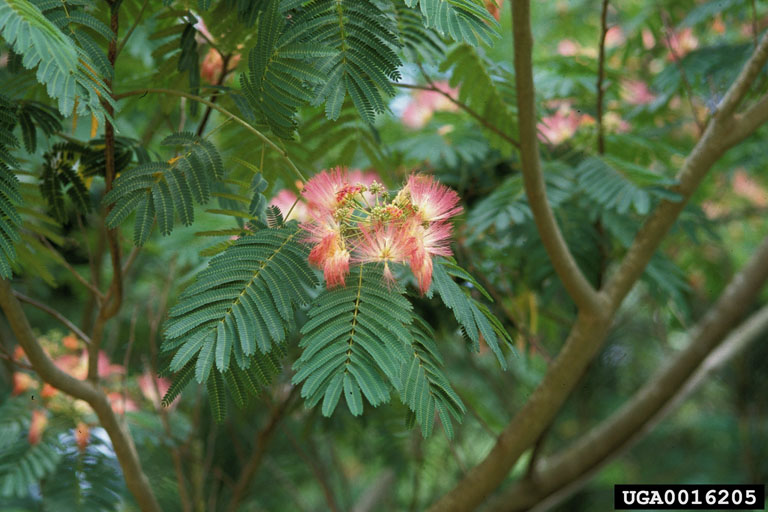
Plant: Silk Tree (Albizia julibrissin), also known as mimosa or silky acacia is a small tree native to Asia.
Identification: A small, leguminous, deciduous tree, 10 to 50 ft tall has single or multiple stems. Lime green to grayish brown branches are slender to stout with light dots (lenticels). There is no terminal bud. The bark is glossy, thin, light brown turning gray with raised corky dots and dashes. Feathery, fern-like leaves are alternate, bipinnately compound and generally, 6 to 20 inches long. There are 8 to 24 pairs of leaf branches, each having 20 to 60 leaflets. Dark green leaflets are 0.4 to 0.6-inch long. Terminal clusters of fragrant flowers that are feathery bright pink with white bases appear from May to July. Seed pods 3 to 7 inches long appear from June to February. These legume pods, each containing 5 to 10 seeds, are light green turning dark brown in fall and whitish-tan in winter. This tree resembles the honey locust (Gleditsia tricanthos) which has longer leaflets (1 to 2 inches long).
Ecology: The silk tree occurs on dry to wet sites and spreads along stream banks, but prefers open conditions although it can persist in the shade. It colonizes by root sprouts and spreads by abundant animal-dispersed and water-dispersed seeds. The silk tree is seldom found above 3,000 ft elevation.
Herbicide Control: For larger trees, cut and immediately apply to stump a 42+% active ingredient of imazapyr (Arsenal AC, Vanquish, or Polaris AC) or 44.4% active ingredient of triclopyr (Garlon 3A or Tahoe 3A) in dilutions as specified on the herbicide label (anytime except March and April). For sapling control, apply 60+% active ingredient of triclopyr (Garlon 4, Remedy, or Tahoe 4E) as a 20% solution (5 pints per 3-gal. mix) in a surfactant (basal oil, methylated seed oil, or vegetable oil) with a penetrant (check with herbicide distributor) or undiluted Pathfinder II to young bark as a basal spray. For re-sprouts and seedlings, apply a 41% active ingredient of glyphosate (Accord, Razor, or Roundup Original) as a 2% solution (8 oz per 3-gal. mix) plus a 60% active ingredient of metsulfuron methyl (Escort XP) at 0.2 oz per 3-gal mix solution in water with a surfactant at a 1% solution (4 oz per 3-gal. mix) to thoroughly wet all leaves anytime from July to August. Alternatively, apply a 40.9% active ingredient of clopyralid (Transline or Clean Slate) as a 0.25% solution (1 oz per 3-gal. mix) plus a 44.4% active ingredient of triclopyr as a 4% solution (1 pint per 3-gal mix) in water with a surfactant at a 1% solution to thoroughly wet all leaves from July to September.
Warning: The active ingredients of imazapyr, metsulfuron methyl, and clopyralid can damage or kill plants with roots in the treated area. Always read and follow label directions carefully.
Photo and Text Credit: (A Field Guide for the Identification of, A Management Guide for) Invasive Plants in Southern Forests, James H. Miller, USDA Forest Service, 2010, ForestryImages.Org
Additional Resources